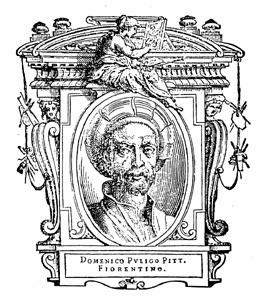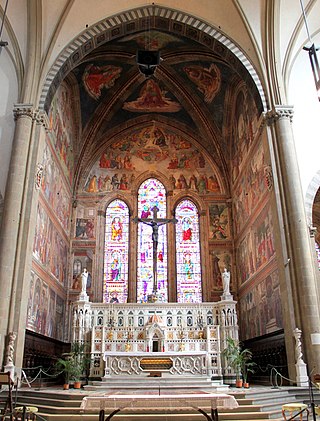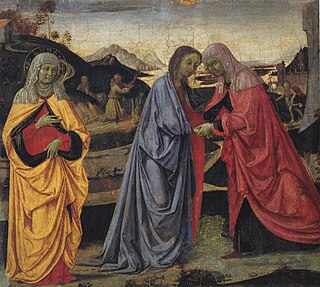
Domenico di Tommaso Curradi di Doffo Bigordi, professionally known as Domenico Ghirlandaio, was an Italian Renaissance painter born in Florence. Ghirlandaio was part of the so-called "third generation" of the Florentine Renaissance, along with Verrocchio, the Pollaiolo brothers and Sandro Botticelli. Ghirlandaio led a large and efficient workshop that included his brothers Davide Ghirlandaio and Benedetto Ghirlandaio, his brother-in-law Bastiano Mainardi from San Gimignano, and later his son Ridolfo Ghirlandaio. Many apprentices passed through Ghirlandaio's workshop, including the famous Michelangelo. His particular talent lay in his ability to posit depictions of contemporary life and portraits of contemporary people within the context of religious narratives, bringing him great popularity and many large commissions.

Santa Maria Novella is a church in Florence, Italy, situated opposite, and lending its name to, the city's main railway station. Chronologically, it is the first great basilica in Florence, and is the city's principal Dominican church.

The Collegiata di Santa Maria Assunta or Duomo di San Gimignano is a Roman Catholic collegiate church and minor basilica in San Gimignano, in Tuscany in central Italy. It contains important cycles of Renaissance frescoes by artists including Domenico Ghirlandaio, Benozzo Gozzoli, Taddeo di Bartolo, Lippo Memmi and Bartolo di Fredi. It falls within the UNESCO World Heritage Site of the "Historic Centre of San Gimignano", with its frescoes being described by UNESCO as "works of outstanding beauty".

The Entombment is an unfinished oil-on-panel painting of the burial of Jesus, now generally attributed to the Italian Renaissance master Michelangelo Buonarroti and dated to around 1500 or 1501. It is in the National Gallery in London, which purchased the work in 1868 from Robert Macpherson, a Scottish photographer resident in Rome, who, according to various conflicting accounts, had acquired the painting there some 20 years earlier. It is one of a handful of paintings attributed to Michelangelo, alongside the Manchester Madonna, the Doni Tondo, and possibly, The Torment of Saint Anthony.

The Three Marys are women mentioned in the canonical gospels' narratives of the crucifixion and resurrection of Jesus. Mary was the most common name for Jewish women of the period.

Domenico Puligo (1492–1527) was an Italian painter of the Renaissance, active in Florence. His real name was Domenico di Bartolomeo Ubaldini.

Florentine painting or the Florentine School refers to artists in, from, or influenced by the naturalistic style developed in Florence in the 14th century, largely through the efforts of Giotto di Bondone, and in the 15th century the leading school of Western painting. Some of the best known painters of the earlier Florentine School are Fra Angelico, Botticelli, Filippo Lippi, the Ghirlandaio family, Masolino, and Masaccio.

The Sassetti Chapel is a chapel in the basilica of Santa Trinita in Florence, Italy. It is especially notable for its frescoes of the Stories of St. Francis, considered Domenico Ghirlandaio's masterwork.

Italian Renaissance painting is the painting of the period beginning in the late 13th century and flourishing from the early 15th to late 16th centuries, occurring in the Italian Peninsula, which was at that time divided into many political states, some independent but others controlled by external powers. The painters of Renaissance Italy, although often attached to particular courts and with loyalties to particular towns, nonetheless wandered the length and breadth of Italy, often occupying a diplomatic status and disseminating artistic and philosophical ideas.
The decade of the 1490s in art involved some significant events.

This article about the development of themes in Italian Renaissance painting is an extension to the article Italian Renaissance painting, for which it provides additional pictures with commentary. The works encompassed are from Giotto in the early 14th century to Michelangelo's Last Judgement of the 1530s.

The Tornabuoni Chapel is the main chapel in the church of Santa Maria Novella, Florence, Italy. It is famous for the extensive and well-preserved fresco cycle on its walls, one of the most complete in the city, which was created by Domenico Ghirlandaio and his workshop between 1485 and 1490.

The Italian Renaissance painter Domenico Ghirlandaio painted the Last Supper of Jesus three times in separate fresco paintings in or near Florence. The oldest of the three is located in the Badia di Passignano (1476). The next painting is the most famous one, painted in the refectory of the Convent of the Ognissanti (1480). The last painting is found at the Convent of San Marco (1486). The last two paintings are found in Florence itself.

The Adoration of the Magi is a painting by the Italian Renaissance master Domenico Ghirlandaio, executed around 1485–1488 and housed in the Ospedale degli Innocenti gallery in Florence, Italy. The predella, painted by Bartolomeo di Giovanni, is in the same site.

The Vocation of the Apostles is a fresco by the Italian Renaissance painter Domenico Ghirlandaio, executed in 1481–1482 and located in the Sistine Chapel, Rome. It depicts the Gospel narrative of Jesus Christ calling Peter and Andrew to become his disciples.

The Portrait of Giovanna Tornabuoni is a painting by the Italian Renaissance painter Domenico Ghirlandaio, executed in 1488 and located in the Museo Thyssen-Bornemisza, Madrid. The portrait was commissioned by Lorenzo Tornabuoni after his wife's death in 1488 and includes many symbolic details.

The Saint Fina Chapel is an Early Renaissance chapel in the right aisle of the Collegiate church of Santa Maria Assunta, located in San Gimignano, Tuscany, Italy. It was designed by Giuliano and Benedetto da Maiano in 1468 to enshrine the relics of Saint Fina. The side walls of the chapel are painted in fresco by Domenico Ghirlandaio with two scenes from her life, executed between 1477 and 1478.

Visitation is a tempera on panel painting usually attributed to Perugino, executed c. 1472–1473, now in the Galleria dell'Accademia in Florence. An early work by the artist from around the same time as Nativity of the Virgin, whilst he was still heavily influenced by Andrea del Verrocchio, it probably originated as part of the predella for a lost altarpiece. It shows the Visitation, with the Virgin Mary's mother Saint Anne to the left. In the left background is Francis of Assisi receiving the stigmata and in the right background is Florence's patron saint John the Baptist - this may indicate that the lost altarpiece was intended for a Franciscan monastery in Florence such as Santa Croce.

The Chiostro della Scalzo or is a cloister in Florence, Italy that originally led to a chapel once belonging to a religious company known as the Compagnia del diciplinati di San Giovanni Battista or della Passione di Cristo. The term "scalzo" makes reference to the barefoot brother who carried the Cross during its public processions.


















